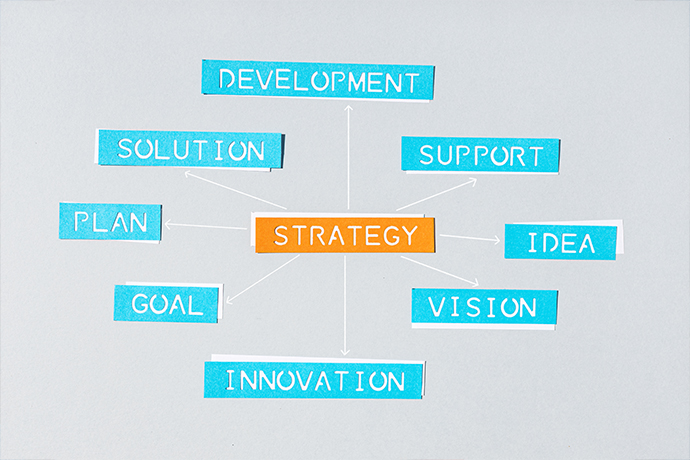 SPEAKERS
SPEAKERS
 TOPICS
TOPICS
Navigating the dynamic business environment demands strategic planning to tackle emerging challenges and achieve goals.

The business environment is dynamic and impacted by both internal and external factors. To overcome certainties and achieve the desired goals, organizations must plan and implement measures that will tackle the emerging challenges.
But keeping an eye on the future and establishing and running your business is not easy. This is where strategic planning comes into play.
Strategic planning is a process where the leaders establish the vision and goals for the organization. Often, they break it down into smaller goals and objectives and lay out the sequence in which they must be achieved to achieve the established strategic vision. The strategic planning process tends to have an average of three to five years and represents the mid-range goals of the organization. Many times, strategic planning is confused with business planning, but the key difference is that a business plan represents short-term goals only, typically a few months.
On the other hand, strategic planning results in a concrete strategic plan in the form of a Word document, a mind map, or even a visual representation through planning and management apps. These plans are shared among the stakeholders in the organization to ensure that everyone has visibility on the direction. Many times, leaders even aim to get a buy-in from stakeholders through these strategic plans.
Now, you may wonder how these plans can benefit an organization.

Do you know that 75% of successful companies have a system to inform employees about the strategic initiatives planned within the organization? This ability to track and manage their strategy can provide far-reaching benefits, such as the ones mentioned below.
One of the biggest advantages of strategic planning is that it gives clarity to employees. They can have a better understanding of their roles and responsibilities and where they can expect to be in the next three to five years. This sense of security and direction is sure to boost employee morale.
Strategic planning encourages the flow of communication across the different levels within an organization. This is more evident in a democratic organizational setup where leaders take inputs from subordinates while formulating plans. Such two-way communication ensures that everyone is committed to achieving the established goals.
Another major advantage of having a strategic vision is that it ensures business continuity. Every business faces internal and external changes, some of which can have a big impact on operations. With a strategic plan, the leaders can envision many of these changes and be prepared for them, so the impact is greatly mitigated. Also, the chances for such events to bring the business to a shutdown are negligible.
A strategic plan is a sign of commitment from an organization toward growth and profitability. When investors and other stakeholders see such a plan, it boosts confidence about the company’s operations and the intent of the leaders to take the company to higher profits. This confidence, in turn, can lead to more investments from investors.
With strategic planning, an organization can better plan its current and future resources. They will have an idea of what resources they will need and can plan on procuring or hiring them. Also, there’s greater accountability and improved resource utilization, resulting in higher operational efficiency.
Strategic planning can be a form of identity for the organization and can help align all activities and processes to it. Moreover, the strategic action plan can provide shared values and goals among the employees, creating a strong bond among them.
All these aspects build a well-rooted organizational culture which in turn, aligns everything towards achieving the mission. Overall, a strategic business plan can bring multiple benefits to organizations, including increased operational efficiency and profitability, besides improving employee morale. But to gain these benefits, you need a well-developed strategic plan.
Real-world strategic plan examples show that taking into account the current state of the organization and its future state along with the potential opportunities and challenges can ensure a higher rate of success.
The strategic planning process depends on the type of business, size of the organization, compliance requirements, and other pertinent factors. Regardless of these factors, here are the broad steps.You can customize them to meet your specific needs:
Start with a current analysis of your operations. Analyze the strengths, weaknesses, opportunities, and threats for your organization, and how you envisage them to change in the future.
It’s common for organizations to have multiple initiatives and goals, but pursuing all of them in parallel can be detrimental. A better approach is to prioritize your goals and set a timeline for each. During this process, identify the strategic vision, business plans, and sub-goals that can lead toward the final mission of the company.
In this process, get all the key executives together, and decide on the strategic planning process. Come up with a plan to achieve the goals, the resources needed, the timelines for each, the evaluation process, and more. This process may require a mind map or apps to present the workflow.
Once the process is set, it is time for implementation. Communicate the goals and processes to the employees and assign responsibilities. Establish ways to measure the performance of employees and subsequent actions for correction.
Make it a habit to continuously monitor the progress against the established strategic planning goals.In case of deviations, understand the cause, and take the necessary action right away.
The above-mentioned broad steps can help you reap the benefits of strategic planning.

In the real world, strategic planning and implementation is not an easy road. There can be many challenges along the way, and it’s common for organizations to lose their direction. In such cases, it’s important to turn to professional help such as experienced business strategy speakers and experts who can bring their experience to the table.